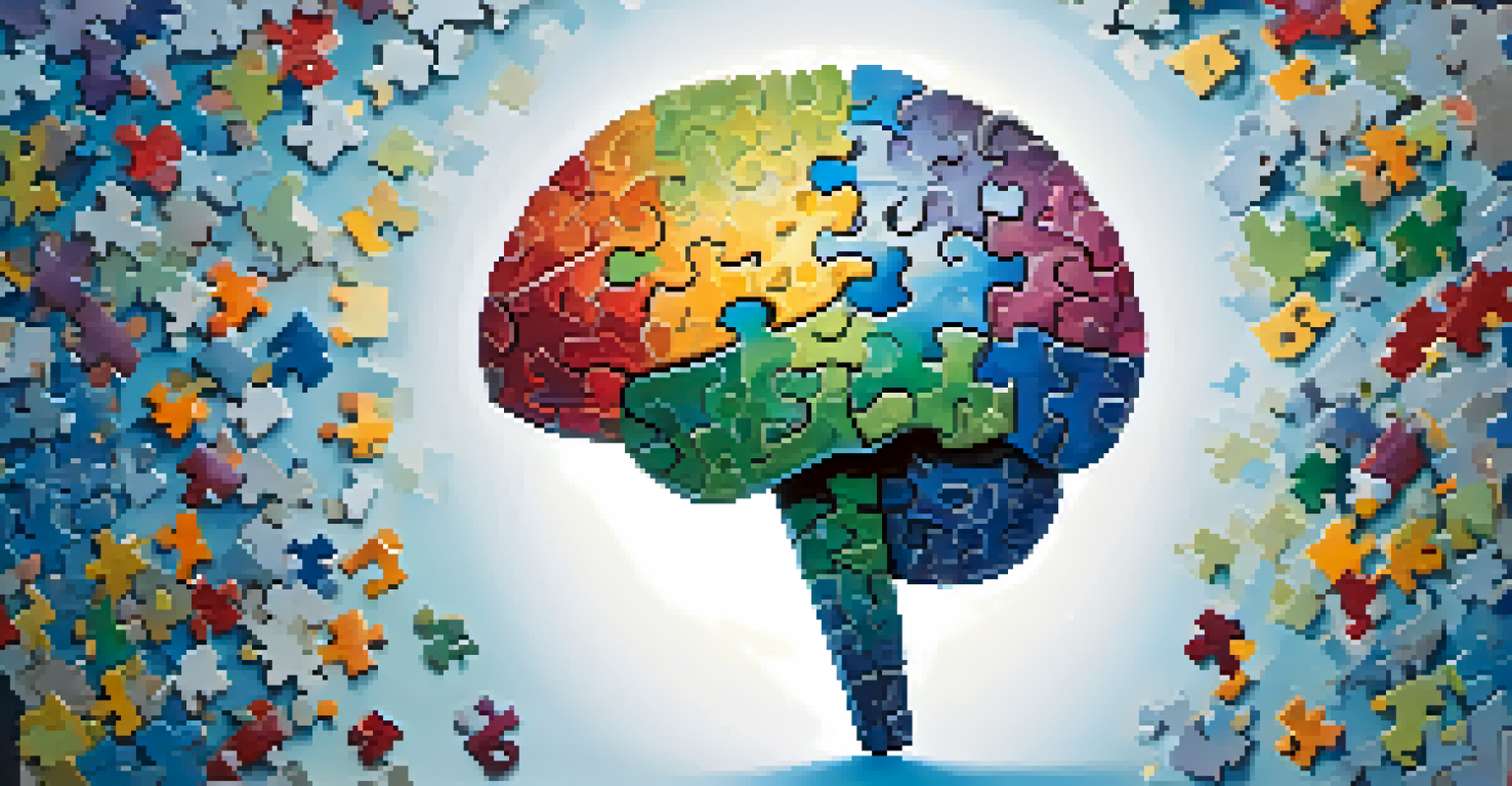Cognitive Flexibility: The Role of Entheogens in Innovation

Understanding Cognitive Flexibility and Its Importance
Cognitive flexibility is the mental ability to switch between thinking about different concepts or to think about multiple concepts simultaneously. It’s like being able to change lanes on a busy highway without losing momentum. This skill is crucial for problem-solving and creativity, enabling individuals to adapt their thinking in response to new information or challenges.
The mind is everything. What you think you become.
In today’s fast-paced world, where innovation is key to success, cognitive flexibility allows us to navigate complexities and think outside the box. For example, a team brainstorming solutions for a product may need to pivot their ideas based on customer feedback, and cognitive flexibility helps them do just that. Without it, we risk becoming stuck in rigid thinking patterns, which can stifle creativity.
Emerging research suggests that enhancing cognitive flexibility could lead to significant breakthroughs in various fields, from technology to the arts. By embracing tools and practices that foster this adaptability, we can better equip ourselves and our teams to face the unknown, ultimately driving innovation forward.
What Are Entheogens and Their Historical Context?
Entheogens are substances, often derived from plants, that can induce altered states of consciousness, typically used in spiritual or shamanic practices. Think of them as keys that unlock different doors in our minds, allowing us to explore new realms of thought and perception. Historically, cultures across the globe have utilized these substances in rituals and ceremonies to enhance spiritual experiences and gain deeper insights.

From the ancient use of peyote by Native American tribes to the sacred mushrooms in Mesoamerican cultures, entheogens have played a pivotal role in human history. These experiences often lead to profound shifts in perspective, which can foster creativity and facilitate problem-solving. In this way, they are not just substances, but gateways to expanded understanding and innovation.
Cognitive Flexibility Explained
Cognitive flexibility is the ability to adapt thinking and problem-solving strategies in response to new information or challenges.
Today, we are witnessing a resurgence of interest in entheogens, particularly in the context of mental health and cognitive enhancement. As more research emerges on their benefits, we are beginning to understand how these substances can aid in developing cognitive flexibility and ultimately enhance our creative capacities.
The Science Behind Entheogens and Cognitive Flexibility
Recent studies suggest that certain entheogens, like psilocybin and ayahuasca, can increase neural connectivity in the brain. This increased connectivity is akin to opening new pathways on a map, allowing for more creative routes to problem-solving. By enhancing the communication between different brain regions, these substances may enable us to think more flexibly and adaptively.
Creativity is seeing what others see and thinking what nobody else ever thought.
In one study, participants who consumed psilocybin exhibited greater cognitive flexibility when engaging in tasks that required creative thinking. They were able to generate more diverse ideas and solutions compared to those who did not use the substance. This points to a fascinating link between altered states of consciousness and enhanced cognitive abilities.
However, it is essential to approach this topic with caution. While the potential benefits are promising, entheogens are not a one-size-fits-all solution. Their effects can vary widely among individuals, and responsible use is crucial to avoid adverse effects. Understanding the science behind these substances allows us to explore their potential while remaining mindful of the risks.
Enhancing Creativity: Entheogens as Tools for Innovators
For innovators and creatives, entheogens can serve as powerful tools to break free from conventional thinking. Imagine being stuck in a mental rut, only to find that a single experience with an entheogen opens up an entirely new world of ideas. Many artists, writers, and thinkers throughout history have attributed their breakthroughs to these transformative experiences.
By temporarily altering our state of consciousness, entheogens can help dissolve the mental barriers that often inhibit creativity. This new perspective allows individuals to approach problems with fresh eyes, leading to innovative solutions that may not have been apparent before. It’s like looking at a puzzle from a different angle and discovering pieces that fit together perfectly.
Entheogens Enhance Creativity
Entheogens can serve as tools for innovators, helping to break conventional thinking patterns and inspiring fresh ideas.
The key lies in intentional use and integration of these experiences into daily life. After an entheogenic experience, it’s vital to reflect on insights gained and how they can be applied to real-world challenges. This practice of integration helps ensure that the creative sparks ignited during the experience can flourish in practical ways.
The Risks and Considerations of Using Entheogens
While the potential benefits of entheogens are captivating, it’s crucial to acknowledge the risks involved. Not everyone will have a positive experience, and some may encounter challenging emotions or thoughts during their journey. It’s similar to venturing into uncharted waters—while the destination may be beautiful, the journey can also be perilous without proper preparation.
Furthermore, the legal status of many entheogens varies widely, which can complicate access and use. Navigating these legal landscapes requires awareness and caution, especially for those interested in exploring entheogens for cognitive enhancement. Responsible use involves understanding the laws and ensuring safe environments for exploration.
Ultimately, those considering entheogens should educate themselves thoroughly and, if possible, seek guidance from experienced practitioners. This approach can help mitigate risks and enhance the likelihood of a positive, transformative experience that supports cognitive flexibility and innovation.
Case Studies: Innovators Who Embraced Entheogens
Many well-known innovators have openly discussed their experiences with entheogens and how these encounters shaped their creative processes. For instance, Steve Jobs famously spoke about how his use of LSD inspired his revolutionary thinking and design philosophy at Apple. Such anecdotes highlight the potential of entheogens to catalyze innovative ideas and breakthroughs.
Another notable example is the musician John Lennon, who credited his experimentation with psychedelics for some of his most creative work, including the iconic album 'Sgt. Pepper's Lonely Hearts Club Band.' These stories serve as inspiring reminders of how altered states can lead to significant artistic and innovative contributions.
Risks of Using Entheogens
While entheogens offer potential benefits, it's essential to approach them cautiously due to varying effects and legal considerations.
While individual experiences will vary, these case studies illustrate a broader trend: the intersection of cognitive flexibility, creativity, and the responsible use of entheogens. By looking at the experiences of others, we can gain insights into how these substances can potentially enhance our own creative journeys.
Future Perspectives: Entheogens and Innovation in Society
As society continues to evolve, the conversation around entheogens and their role in enhancing cognitive flexibility is gaining traction. With increasing interest in mental health and well-being, more individuals and organizations are exploring how these substances can be integrated into therapeutic and creative practices. This shift could pave the way for a new era of innovation and creativity.
Looking ahead, we may see more structured research initiatives aimed at understanding how entheogens can foster cognitive flexibility in diverse settings—from corporate environments to educational institutions. Imagine a future where workshops incorporate guided entheogenic experiences to unlock creative problem-solving among teams. The possibilities are intriguing and worth exploring.

Ultimately, the future of entheogens and innovation will depend on responsible use, scientific research, and open dialogue. By fostering a culture that values creativity and adaptability, we can harness the potential of entheogens to drive innovation forward in meaningful ways.